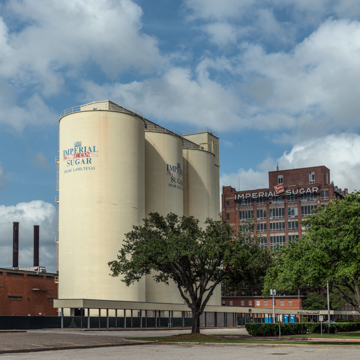You are here
Building (Imperial Sugar Company Char Filter House)
The dominating landmark of “old” Sugar Land is the Char Filter House of the Imperial Sugar Company, the centerpiece of a refinery begun in the 1870s by San Antonio–based sugar planter and refiner E. H. Cunningham. The exposed concrete-framed building has red brick–faced piers and spandrels framing large openings filled with metal-framed glazing. On the flat coastal plain, the Char Filter House loomed like a skyscraper to advertise Imperial's corporate identity.
E. H. Cunningham acquired what was originally Oakland Plantation on Oyster Creek where sugar had been grown since 1838. Cunningham and other large Fort Bend County growers, such as L. A. Ellis of Austin, surpassed Brazoria County in cane production in the later nineteenth century. Between 1877 and 1883, Cunningham and Ellis leased and managed the entire population of the Texas prison system to ensure a dependable supply of field labor.
In 1893 Cunningham modernized by building one of the largest sugar refineries in the nation, part of a comprehensive, highly capitalized expansion of operations that also included development of a company-owned settlement around the refinery. Poor management caused Cunningham to sink into debt and in 1908 Galveston businessman I. H. Kempner bought the twenty-thousand-acre plantations, refinery, and railroad, which were incorporated as the Imperial Sugar Company. Imperial sold some of Cunningham's growing land to the state as a prison farm after the State of Texas terminated convict leasing in 1910. Managing partner W. T. Eldridge rehabilitated the Sugar Land townsite, constructing housing and other services to attract workers and their families, especially German and Moravian Texans.
The Char Filter House was built during the expansionary decade of the 1920s to process Cuban and Hawaiian sugar after cane ceased to be grown in the Texas Sugar Bowl. In the post–World War II period, Imperial divested itself of its Sugar Land real estate, selling company housing to employees and encouraging Sugar Land's incorporation as a city, which occurred in 1959. Until 1988, the corporation was privately held and managed by the Kempner family. An aggressive expansion campaign during the 1990s ended in 2001 when Imperial filed for bankruptcy. At the end of 2002, the corporation closed the Sugar Land refinery. In 2005 Cherokee Investment Partners of Raleigh, North Carolina, specializing in the remediation and redevelopment of brownfield sites, bought the 160-acre refinery tract. In partnership with the General Land Office of the State of Texas, owner of an adjoining 525 acres along the east side of TX 6, Cherokee began development of a planned community that involves preservation of the Char Filter House. Johnson Development Corp. of Houston took over the project for what it calls “Imperial.” Nonhistoric portions of the complex were demolished in late 2010 in preparation for this redevelopment.
Writing Credits
If SAH Archipedia has been useful to you, please consider supporting it.
SAH Archipedia tells the story of the United States through its buildings, landscapes, and cities. This freely available resource empowers the public with authoritative knowledge that deepens their understanding and appreciation of the built environment. But the Society of Architectural Historians, which created SAH Archipedia with University of Virginia Press, needs your support to maintain the high-caliber research, writing, photography, cartography, editing, design, and programming that make SAH Archipedia a trusted online resource available to all who value the history of place, heritage tourism, and learning.

